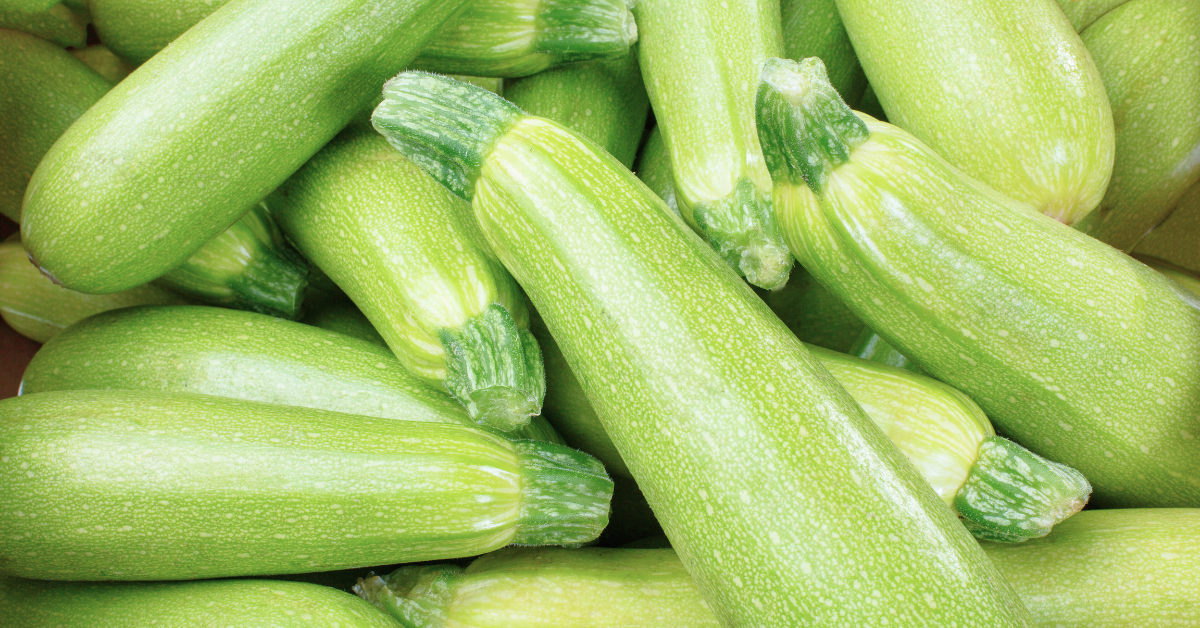How to Grow Zucchini Vertically
Reaching New Heights How to Grow Zucchini Vertically
Zucchini is very easy to grow vertically. With a few simple steps, you can continue to grow and harvest zucchini all summer long. Let me show you how easy it is to grow zucchini vertically.
How to Train Your Zucchini to Grow Vertically
The Stake and Twine Method
The most popular method is to drive a 6-foot stake into your garden bed, 12-16 inches deep, and tie the zucchini plant to the stake as it grows. Ideally, place the stake in the garden bed at the time of planting or before to avoid disturbing the root system and potentially causing nutrient delivery problems that could lead to blossom end rot.
Why Not Use a Trellis?
The large leaves of zucchini plants can become compressed against a trellis, making it difficult to maneuver the plant without damaging the leaves and stems.
Preferred Method – Use a Trellis Frame
If you’re growing in raised beds and want to grow zucchini vertically after it has already matured, you can still do it without driving a wooden stake into the bed. Simply build a trellis frame. This frame is similar to a raised bed garden trellis but without the netting.
If you have a larger bed and want to grow multiple zucchini plants vertically in a row, insert a vertical cross member during the frame assembly for each plant. This will create a structure to hold each plant upright.
Steps to Grow Zucchini Vertically
Step 1: Attach an Anchor Screw
Gently lift the zucchini or summer squash plant and lean it against the frame. This will help you determine where to secure the plant. Drill a screw into the trellis frame at this location, leaving about 1 to 1.5 inches protruding from the wood to attach the wire.
Step 2: Attach One End of a 10-12 Inch Piece of Wire to the Anchor Screw
Cut a 10-12 inch piece of wire with a rubber outer coating, and wrap one end around the anchor screw.
Step 3: Wrap the Wire Around the Plant Stem
Wrap the wire around the plant stem to keep it vertical. The wrap should be loose enough to allow for stem growth while still holding the plant upright.
Step 4: Wrap the Tail End of the Wire Around the Anchor Screw
Finally, wrap the tail end of the wire around the anchor screw. This will secure the plant vertically as it continues to grow and produce fruit.
Growing Zucchini Squash Vertically
About once a week, as the plant grows, the top will begin to lean towards the ground. Reposition the plant by lifting it up against the frame and inserting a new screw and wire to hold it up.
There are many benefits to growing zucchini and all summer squash vertically:
- Easier to prune: Pruning is simpler as everything is off the ground and accessible.
- Prevents powdery mildew: Keeping the branches off the ground improves airflow around the plant.
- Space-saving: Vertical growth takes up less space and allows for a longer growing season without plants interfering with each other.
- Improved pollination: Flowers are more visible to pollinators, making them easier to find.
How to Grow Zucchini Vertically in A Pot
Materials Needed:
- Large pot (at least 5 gallons)
- High-quality potting soil
- Zucchini seeds or seedlings
- Trellis or sturdy stakes
- Plant ties or soft twine
- Fertilizer (optional)
Steps:
Choose the Right Pot:
Select a pot that is at least 18 inches in diameter and 18 inches deep. A larger pot will provide more room for root growth and stability.
Prepare the Pot:
Fill the pot with high-quality potting soil, leaving about 2 inches from the top.
Planting:
- If using seeds, plant them about 1 inch deep. If using seedlings, plant them at the same depth they were in their original container.
- Water the soil thoroughly after planting.
Support Structure:
Insert a trellis or sturdy stakes into the pot. Ensure they are well-secured and can support the weight of the growing plant. A trellis should be at least 5-6 feet tall.
Positioning:
Place the pot in a location where it will receive at least 6-8 hours of direct sunlight per day.
Watering:
Keep the soil consistently moist but not waterlogged. Zucchini plants need regular watering, especially in hot weather.
Training the Plant:
- As the zucchini plant grows, gently tie the main stem to the trellis or stakes using plant ties or soft twine. Be careful not to tie too tightly to avoid damaging the stem.
- Continue to tie the plant to the support structure as it grows taller, spacing the ties about 6-12 inches apart.
Pruning:
- Remove any lower leaves that touch the soil to prevent disease.
- Pinch off the tips of side shoots to encourage the plant to grow vertically and focus energy on producing fruit.
Fertilizing:
Apply a balanced, water-soluble fertilizer every 4-6 weeks to promote healthy growth and fruit production.
Pollination:
Zucchini plants require pollination to produce fruit. If you notice a lack of pollinators, you can hand-pollinate the flowers by transferring pollen from the male flowers to the female flowers using a small brush or cotton swab.
Harvesting:
Harvest zucchini when they are about 6-8 inches long for the best flavor. Regular harvesting encourages the plant to produce more fruit.
Tips:
- Variety: Choose compact or bush varieties of zucchini for container growing.
- Mulching: Mulch the soil surface to retain moisture and suppress weeds.
- Pest Control: Keep an eye out for common pests like aphids and squash bugs. Use appropriate organic pest control methods if needed.
How to Grow Zucchini Vertically in Tomato Cage
Growing zucchini vertically using a tomato cage is an excellent method to save space and keep the plant organized. Here’s a step-by-step guide:
Materials Needed:
- Tomato cage (preferably a tall and sturdy one)
- Large pot (at least 5 gallons)
- High-quality potting soil
- Zucchini seeds or seedlings
- Plant ties or soft twine
- Fertilizer (optional)
Steps:
Choose the Right Pot:
Select a pot that is at least 18 inches in diameter and 18 inches deep. A larger pot ensures adequate root space and stability.
Prepare the Pot:
Fill the pot with high-quality potting soil, leaving about 2 inches from the top.
Planting:
- If using seeds, plant them about 1 inch deep in the center of the pot. If using seedlings, plant them at the same depth they were in their original container.
- Water the soil thoroughly after planting.
Install the Tomato Cage:
Insert the tomato cage into the pot, pushing it down so it is stable and well-secured. The cage should be tall enough to support the mature zucchini plant.
Positioning:
Place the pot in a sunny location where it will receive at least 6-8 hours of direct sunlight per day.
Watering:
Keep the soil consistently moist but not waterlogged. Zucchini plants need regular watering, especially in hot weather.
Training the Plant:
- As the zucchini plant grows, guide the main stem through the openings of the tomato cage. Use plant ties or soft twine to gently secure the stem to the cage.
- Continue to tie the plant to the cage as it grows taller, spacing the ties about 6-12 inches apart.
Pruning:
- Remove any lower leaves that touch the soil to prevent disease.
- Pinch off the tips of side shoots to encourage the plant to grow vertically and focus energy on producing fruit.
Fertilizing:
Apply a balanced, water-soluble fertilizer every 4-6 weeks to promote healthy growth and fruit production.
Pollination:
Zucchini plants require pollination to produce fruit. If you notice a lack of pollinators, you can hand-pollinate the flowers by transferring pollen from the male flowers to the female flowers using a small brush or cotton swab.
Harvesting:
Harvest zucchini when they are about 6-8 inches long for the best flavor. Regular harvesting encourages the plant to produce more fruit.
Tips:
- Variety: Choose compact or bush varieties of zucchini for container growing.
- Mulching: Mulch the soil surface to retain moisture and suppress weeds.
- Pest Control: Keep an eye out for common pests like aphids and squash bugs. Use appropriate organic pest control methods if needed.
Do Zucchini Plants Climb?
Zucchini plants are generally bush-type rather than climbing plants. However, they can be trained to grow vertically with the support of a trellis, tomato cage, or other vertical structures. Here’s more about their growth habits and how to train them:
Growth Habits of Zucchini Plants
- Bush Varieties: Most zucchini plants grow in a bush form, spreading out from a central point. They do not naturally climb but can be guided to grow vertically.
- Vining Varieties: There are some vining varieties of zucchini that naturally produce longer vines. These are more suited for vertical growing.
If yellow squash and zucchini squash are planted and grown next to each other will they develop the same flavor?
Yellow squash and zucchini squash, when planted and grown next to each other, will maintain their distinct flavors and characteristics. The differences in flavor, texture, and appearance between yellow squash and zucchini are due to their unique genetic makeup rather than their proximity in the garden. Here are a few key points to understand:
Flavor and Characteristics
- Zucchini: Typically has a mild, slightly sweet flavor with a firmer texture.
- Yellow Squash: Often has a slightly sweeter and sometimes nuttier flavor with a softer texture, especially when cooked.
Cross-Pollination
- Cross-Pollination Effects: If yellow squash and zucchini cross-pollinate, it will not affect the flavor, texture, or appearance of the fruits they produce in the current growing season. The characteristics of the fruit are determined by the plant’s genetics, which are already set for the current growing season.
- Future Generations: Cross-pollination may affect the seeds produced by the plants. If you save and plant these seeds, the resulting plants might produce fruits with mixed characteristics, potentially affecting flavor and appearance. However, this would only be noticeable in the next generation of plants grown from those seeds.
Growing Conditions
- Growing Conditions: Both types of squash require similar growing conditions—full sun, well-draining soil, and regular watering. These conditions will affect the overall health and productivity of the plants but not their inherent flavor.
Harvesting and Cooking
- Harvest Timing: Harvesting zucchini and yellow squash when they are young and tender will provide the best flavor. Overgrown fruits can become tough and less flavorful.
- Culinary Uses: Both types of squash can be used interchangeably in many recipes, but their slight flavor and texture differences can complement each other in mixed dishes.






Leave a Reply